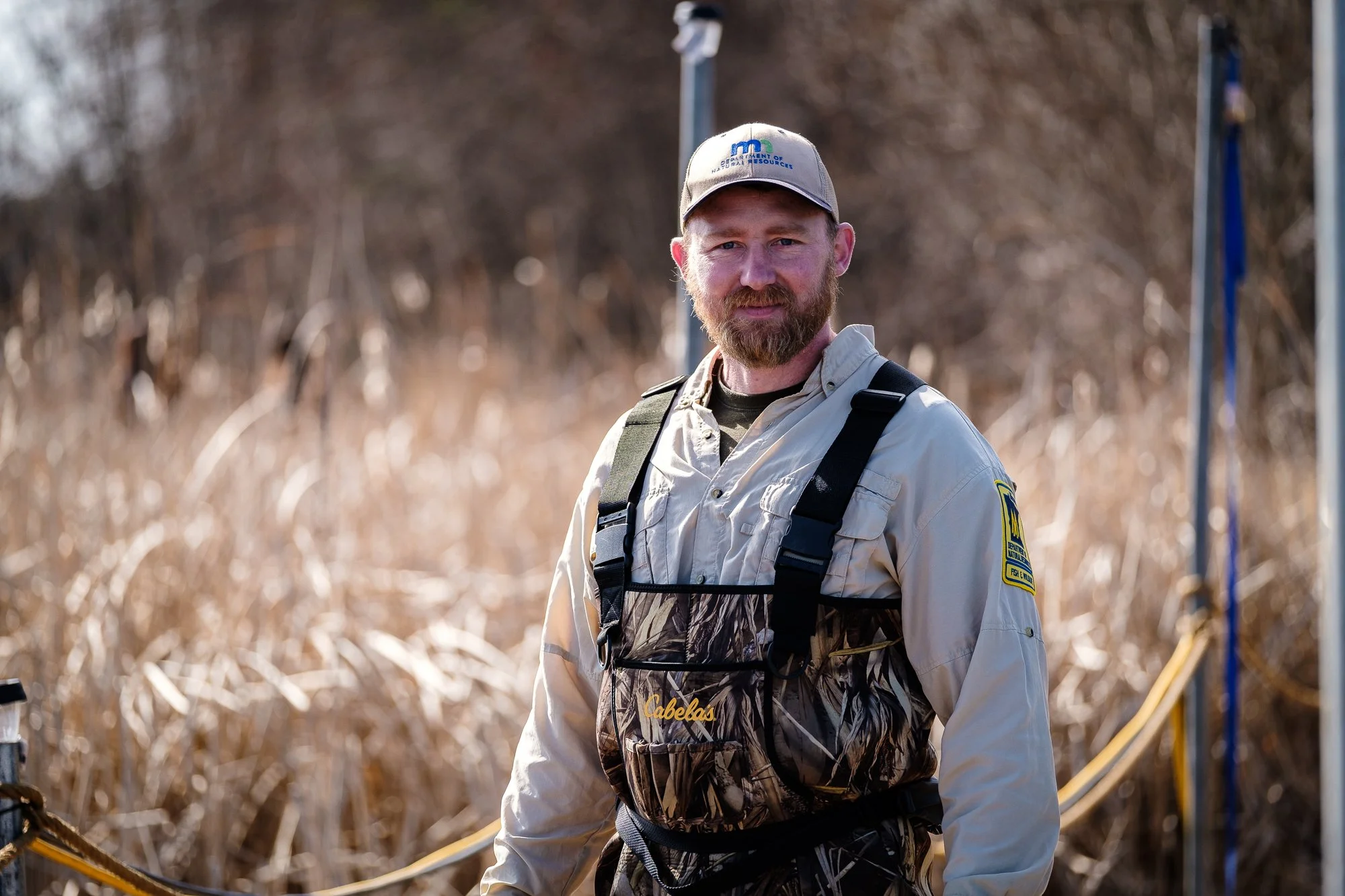One thing is certain, walleyes are biting when we find them. The caveat, is finding them and the anglers who want to be most consistent, must fish a wider variety of structures and be willing to think about both fall, and summertime fishing patterns at the same time.
Gabriel, Kim and Nathan Milius walleye fishing on Lake Winnie September 24, 2024
According to the calendar, we should be experiencing solid fall walleye fishing patterns. And we almost are, we had a “spurt” of fall weather last week, and walleyes responded well, and in some areas of the lake, so did perch. Now, we’re back into a period of summer-like weather, Surface temperatures are in the 66-to-70-degree range, and there’s been lots of sunshine and calm weather. Daytime anglers may be working harder at producing consistent catches of walleyes, but folks who fish during prime time, twilight periods are having better luck.
On Big Winnie, there are two massive, mid-depth flats, one at the northwest corner, one at the southeast corner. On these flats, walleyes, perch and pike of all sizes can be viewed constantly on the screens of our electronics. Sometimes they bite, sometimes they don’t, but they have been located over the tops of low-lying vegetation for weeks now. According to our family friend Dusty Snyder, the magic water depth is 9 feet deep. “No matter where I go, it seems like the most active fish come out of that depth.”
Walleye, perch, pike and more holding above vegetation on large flat
Working over grass on the flats with jig and minnow presentations is effective but can also be tedious. Allowing the jigs to slip too low into the vegetation causes fouled hooks and reduces efficiency. Some of our guests are reporting more consistent catches by using trolling presentations. Whether they use spinners tipped with live bait, or shallow running crankbaits, they can spend more time fishing, and less time removing moss from their hooks. The best trolling speeds for spinners has been 1.1 to 1.3 MPH, and faster for crankbaits, 1.7 to 2,1 MPH.
Timing the bite on the flats seems to be important, fishing early in the morning has been less productive than late afternoons and evening. We think it’s possible that many of the “flats fish” are feeding after dark, so folks find them less vulnerable during the morning. Later, they are hungrier and strike more often; you be the judge, give it a try and let us know what you think.
Crews like the Milius family (pictured throughout) who show lots of determination, are having good luck fishing on some of the lakes deeper bars. Key depths on the bars range from 16 to 22 feet of water, and walleyes in the higher range bite better than those in the lower range. Fish have been found in numerous areas such as the Bena Bar, Sugar Bar, Horseshoe, Moxies Hole and others. Moving often and checking out the “spot-on-a-spot” locations like inside corners, points and feeding shelves are a good strategy for locating pods of fish. Many of these fish are migrating from place to place, so don’t be concerned if it takes a few stops to find a group of active fish, just keep searching, and you will find some.
Nathan (L) and Gabriel (R) Milius showing off a nice Winnie Walleye mid-lake double September 24, 2024
Presentations vary, drop shots with night crawlers or large lively minnows is productive. Jigging baits like ripping raps or puppet minnows are working, slip floats with night crawlers have produced fish too. For our guests, jig and minnow presentations are most common, ¼ to 3/8 ounce live bait jigs tipped with golden shiners or large fatheads have been productive. There have been a lot of fish caught using gold jigs, but glow-perch, green-orange and green-chartreuse have also been productive.
Shoreline fishing for Walleyes has its good days, and its bad ones. When the wind blows and the skies are cloudy, walleyes have been active on the breaklines or shallow rocks. Key depths have ranged between 6 and 12 feet, with the shallow end of the spectrum often being best. There are walleyes on all 4 sides of the lake, so selecting the best spots depends entirely on the wind direction and speed. Look for areas where the wind is quartering into the shoreline, proving good opportunities for drift fishing. Avoid the calm shoreline, and avoid areas where the wind blows directly onto the breakline, either will cause difficulty in boat control.
Kim Milius with fat Winnie Walleye from the flats September 24, 2024
There have been some folks trolling the shoreline breaks, but jigging has been far better for most folks. Use 1/8 or ¼ ounce jigs tipped with minnows and use a vertical hop-drop-hop-drop motion to entice strikes.
Fishing the shoreline breaks, you’ll encounter scattered, nomadic schools of Jumbo Perch and some of them are running good size, 10 to 12 inches. It seems that every patch of vegetation, shallow rock, or depression has the potential to be productive. If you like perch, and want to harvest some, then don’t let any opportunity go to waste. They appear to be on the move constantly, and do not linger in any given area very long.
The best way to find them is probably to troll spinners or smaller crawfish pattern crankbaits. Once located, jig and minnow presentations will be more efficient. Hold your boat stationary, cast and retrieve, or jig vertically using small, 1/16 or 1/8 ounce jigs tipped with fatheads.
Crappies have teased us a few times, but folks have had trouble catching them consistently. It seems that every time we get a period of cold weather, some of the fish move away from the cabbage patches and into open water. When we can see them, they strike, most folks say. The trouble is that when the weather warms up, they move back into vegetation where they are more difficult to locate. They’ll eventually move into open water, but not before the shallow vegetation becomes uninhabitable, likely after we receive a hard frost. There is a good resource for folks who love fall crappie fishing, much of the formation of it occurred here, in Cutfoot Sioux. Learn more by reading the article “Following Out Fall Crappies”.
If you’re determined to locate crappies, use the early morning and late afternoon to search. That’s when they’re most active along the breaklines. Trolling spinners, jigging with soft plastic action tails, or beetle spins and small crankbaits are all good search lures.
Northern Pike fishing has been good, especially along the north shore. Trolling, casting or fishing with live minnows are all productive presentations. Key depths vary depending on where you’ve located healthy, green vegetation. Most consistent depths have ranged between 8 and 10 feet of water, but check both shallower and deeper too. If you have side imaging electronics, use it to see the patches of vegetation and fish all of them.
One group that fished for pike early this week reported great action for fish in the protected slot. There are numerous fish in the 23-to-25-inch range, with a smattering of larger, 27 to 28 fish showing up in the mix. Right now, smaller fish, below the protect slot are few and far between along the north side of the lake. To catch more eater size, 20-to-21-inch size fish, a better choice would be the west side of the lake, there are many more small pike along the 10 to 12 foot breakline between Sugar and Mallard Points.
We’ve really appreciated you taking the time to check out our fishing reports. We’ve done our best to keep them up-to-date and accurate. Looking at the weather, it doesn’t seem like it should be, but for us, the fishing season is winding down. For us, the hunting is winding up and soon, our cabins will host more grouse hunters than anglers. Fishing reports will be less frequent now, but we’re probably going to post an occasional update about any significant, new developments, check them out when you have time.



























